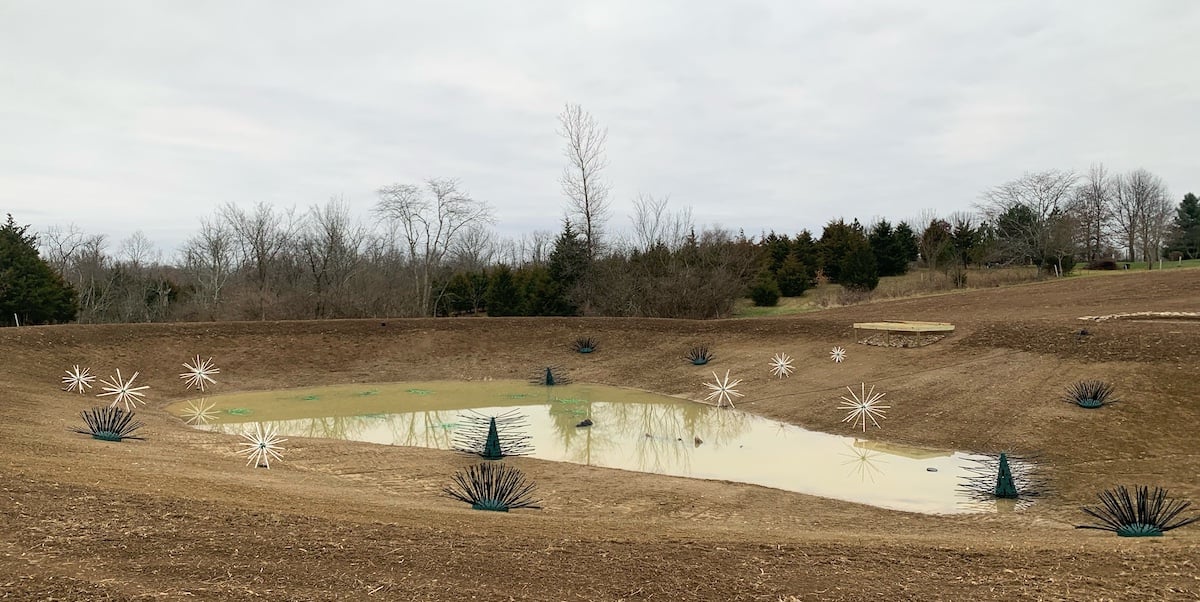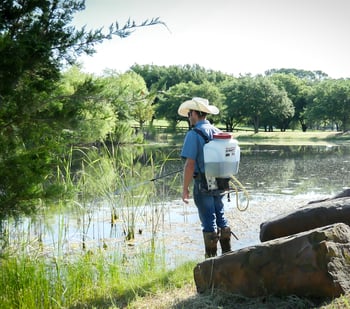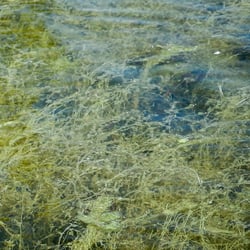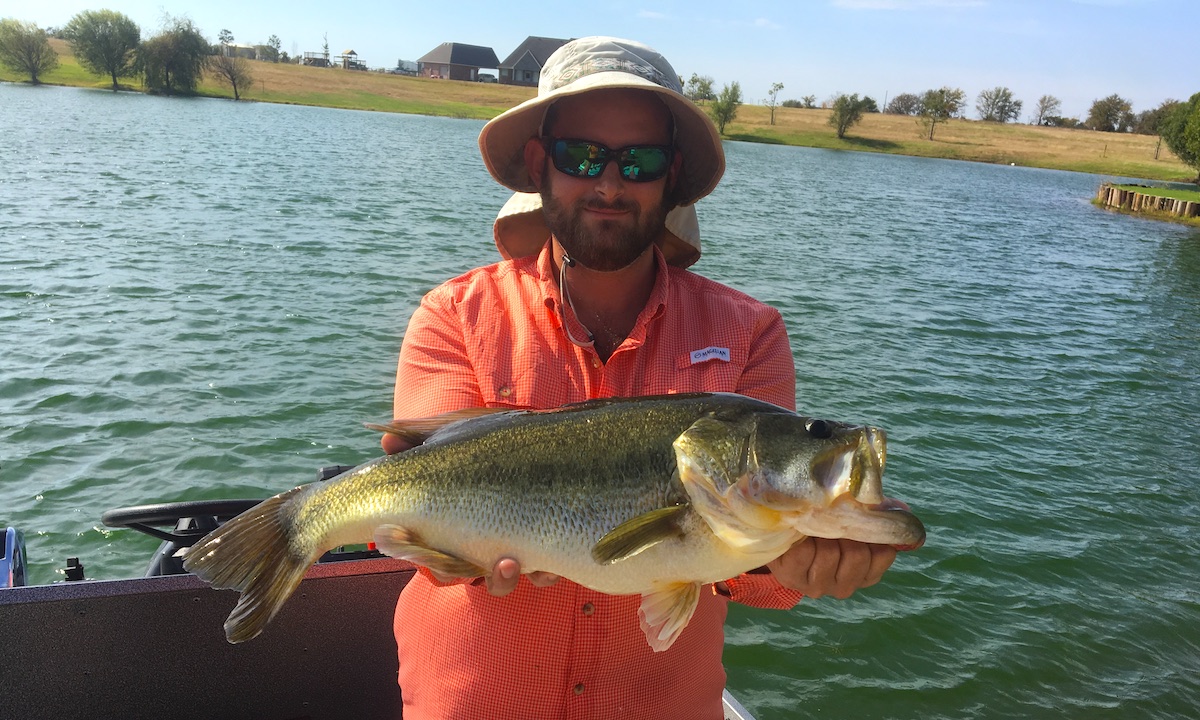When it comes to building a quality private fishery, it doesn't have to be a large body of water requiring extensive maintenance to be a productive bass fishery.
Instead, you can build a very modest, simple body of water, and still have very productive fishing with just a little bit of guidance.
Three Steps to a Productive Bass Fishery
Creating a productive fishery can be broken down into three main facets:1. Proper Stocking Densities
2. Adequate Habitat Availability
3. Proper Annual Maintenance
Now, these are the basics for creating and managing a productive fishery.
If you want to achieve a trophy-class fishery, you'll want to incorporate more intensive management tactics to your pond management for big bass.
Just remember, those will require additional investments of time and money. However, not everyone can invest the resources it takes or have a body of water large enough to make these investments worthwhile.
Instead, a lot of pond owners just want a place where they can put the work in themselves and have the chance to catch healthy, quality fish.
1. Proper Stocking Ratios
First, let's discuss the importance of initially stocking the proper densities of the appropriate species into your pond.
If your population dynamic is not balanced, the time it takes to achieve your goal is dramatically increased. The rate you stock your predators in a new pond is significantly lower than the rate at which you would stock your forage base.
Suppose there is an insufficient supply of Bluegill to initially survive and grow alongside your Bass as you establish your fishery. In that case, it will be difficult to create a sustainable broodstock population to supply your Bass with the calories they need to survive and grow.
Yes, it may seem excessive to stock 800-1,000 Bluegill per acre. However, once you consider all the factors that decrease that initial number, you'll realize it's not excessive at all. When you stock your pond, some fish won't survive the introduction process, some of your forage population will be consumed by other pond predators, and then more will be consumed by the Bass that are sufficiently large.
Remember, it takes on average around 10 pounds of forage resources for your Bass to gain one pound of weight.
When you extrapolate how many 3 to 5-inch Bluegill it takes to make up 10 pounds, you will quickly see that yes, you do need that many Bluegill.
We recommend 10-15 pounds of Fathead Minnows, 800 Bluegill, and 80 Largemouth Bass per surface acre for brand new ponds.
Stocking at these rates will ensure you have an adequate forage base for your new fishery. The fish will be in the correct proportions as they begin to reproduce.
2. Supply Adequate Habitat
With the correct predator/prey dynamic within your fishery, you need to make sure there are ways for these fish to carry out their daily interactions.
Ensuring you have adequate habitat availability for both your forage species and your predators will allow your fish to either hide or hunt more effectively.
Your forage species need highly complex or tightly woven cover to evade your predator species and survive long enough to be recruited to a larger size class. Whereas your Bass need cover with a little less complexity and plenty of ambush points. Bass are highly efficient ambush predators. With sufficient habitat, your Bass will expend less energy capturing prey with this method than they would by swimming down their game in open water.
Providing your Bass with habitat that benefits this feeding style will facilitate improved growth rates.

You can provide habitat from a wide variety of sources. Managed portions of aquatic vegetation, old trees, and bushes sunk to create brush piles or artificial habitat can all provide adequate habitat for your fishery. However, it is crucial not to utilize old tires, PVC piping, or other materials that can leach harmful chemicals into the water.
We recommend that 10-15% of the total surface area of the pond have some type of cover available for your fish.
Having a diverse combination of habitat materials spread out over the entire fishery and in all water depths provides your fish with adequate cover for all species throughout their seasonal movements. It is also essential to have habitat available during the winter months. Relying primarily on aquatic vegetation in the shallow portions of your pond can turn into an issue during the colder months. As the vegetation dies off during the late fall and winter, your fish are left without cover and exposed to increased predation risks, like pesky Cormorants.
3. Annual Pond Management
Finally, proper annual management is required to ensure your fishery stays healthy year after year.
Annual maintenance primarily consists of:
A. selective predator harvests
B. aquatic vegetation control
Controlling these two aspects will help to maintain the proper population dynamic within your pond.
In approximately the 3-4th year after stocking, you should implement predator harvests.
Why You Should Practice Selective Bass Harvest from Your Pond
Selective harvest will help prevent the Bass population density from exceeding the carrying capacity of the pond.
If left unmanaged, the Bass will continue to reproduce and potentially become stunted because of too much competition.
This situation occurs when the Bass population predates excessively on the Bluegill until there aren't enough resources to promote weight gain or even maintain a healthy weight compared to their overall length.
What is the Right Harvest Rate for Pond Bass?
We typically recommend removing 30 Bass per acre that are smaller than 12-inches. This harvest will ensure a better allocation of resources among the remaining population, allowing the Bass to grow at their maximum potential and ensuring there isn't an excess of predation on your forage species.
Maintaining proper predation rates will help to prevent the need for annual baitfish stocking to rebound population densities.

Manage Your Pond’s Aquatic Vegetation Annually
Controlling aquatic vegetation will help ensure your Bass have adequate access to your forage resources and help limit the threat of oxygen depletion that could cause a fish kill.
Why Cellular Respiration is Hard on Ponds
Excessive growth of aquatic vegetation can produce oxygen during the day through photosynthesis. However, at night the plants' cellular function switches to respiration. During cellular respiration, these plants consume the dissolved oxygen in the water the same way your fish do. This process can spell disaster during the summer months when water temperatures are elevated, and the amount of oxygen the pond can hold is reduced.
When this situation occurs, the available oxygen is at its lowest right at sunrise.
Fish can be seen piping on the surface, trying to get any available oxygen they can before they begin to die off. Managing aquatic vegetation is the key to preventing this devastating event from occurring in your fishery.
Make Sure Your Bass Can Eat Your Bait Fish
Controlling aquatic vegetation growths is also pivotal in ensuring your Bass have adequate access to your forage fish.

Dense growth of aquatic plants creates a very complex habitat that is difficult for your Bass to navigate. In this scenario, your baitfish have a sizable advantage in their survivability because they can find all the resources they need in these mats, reducing their need to leave and be exposed to predation.
Now, this isn't necessarily a bad situation if it's managed properly. Your baitfish can utilize controlled portions of aquatic vegetation as habitat for this exact reason. It gives your baitfish a chance to grow and reach a size that is more beneficial for your Bass to consume or to your fishery as a whole when they achieve broodstock sizes.
Why Extremely Dense Aquatic Vegetation is Bad for Ponds and Lakes
The problems come when vegetation mats overtake the fishery, and your Bass aren't able to feed sufficiently. You end up with a pond full of Bluegill in the small and moderate size classes and skinny and stunted Bass because they cannot access your forage resources to put on weight and reach their potential.
3 Basic Steps for Creating a Successful Bass Pond
Even with modestly designed ponds, you can achieve greatness if you follow these few steps:
- Start by stocking the proper species at the appropriate densities.
- Ensure there is adequate habitat available throughout the water columns to provide season and life-stage appropriate cover.
- Annually, control aquatic vegetation and, starting in year 3 or 4 after stocking, conduct selective harvests.
Follow these simple steps, and you will be on your way to catching quality Bass in no time!
Trust Pond King for Managing Texas Ponds and Lakes
If you have any questions on management strategies or tactics for your pond, feel free to call or contact us anytime ! The Pond King fisheries biologists are ready to serve you!
See y'all down at the pond!




